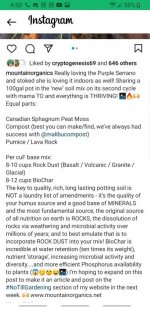Reallifegrows
New member
Hey everyone!
So many of you may know of Mountainorganics on IG, maybe not. I'm intrigued by his more recent soil recipe... previously he had used meals like crab, etc.... now he solely uses rock dust for his micros/macros; I'll post below:
His plants speak for themselves but I would still be concerned with heavy metals such as Iron and Aluminum as such high rates of rock dust.
I know proper lab testing, saturated paste test, tissue analysis, etc is likely needed to find the answer but figured I'd drop this here if anyone has any thoughts or experiences with something like this.
Many thanks :]
So many of you may know of Mountainorganics on IG, maybe not. I'm intrigued by his more recent soil recipe... previously he had used meals like crab, etc.... now he solely uses rock dust for his micros/macros; I'll post below:
His plants speak for themselves but I would still be concerned with heavy metals such as Iron and Aluminum as such high rates of rock dust.
I know proper lab testing, saturated paste test, tissue analysis, etc is likely needed to find the answer but figured I'd drop this here if anyone has any thoughts or experiences with something like this.
Many thanks :]



